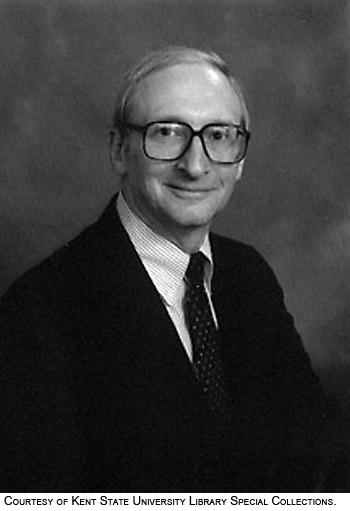Albert Borowitz, Author 1981 CLEVELAND ARTS PRIZE FOR LITERATURE
Prior to 1981, Borowitz had already established a national reputation for his essays on true crime. A decade earlier, he published an essay entitled “Snows on the Moors,” in which he explored a 1963 triple murder in Manchester, England. The eponymous “Snows” were writers C. P. Snow and his wife Pamela Hansford Johnson, both of whom responded to the case in their own fiction. She, who attended the trial, concluded that such brutality was an inevitable result of their permissive times; he, who observed from a distance, decided the roots of evil went much deeper than social mores. Their difference of opinion convinced Borowitz that the truth of any crime rests with the interpretation of others; and that criminal trials belong only for a brief time to the courts. Moreover, he discovered, many crimes find their way into works of literature or art because of what they reveal about human behavior. And that sometimes the artists themselves are the perpetrators. These connections made “truth” for Borowitz far more interesting than fiction. Early on, he made lasting contributions to the field of crime writing. In a 1971 essay on the case of Aldo Braibanti, he coined the expression “Psychological Kidnapping.” The phrase came to include all forms of mind control. It remains in use today. His first collection of true crime essays appeared in 1977 under the title Innocence and Arsenic: Studies in Crime and Literature. The essay that prompted the book’s title describes the crimes of 19th century Swedish writer/composer C. J. L. Almquist, who did not believe in guilt. Charged with embezzlement and attempted murder (using arsenic he obtained for supposed “research” for a novel), he left Sweden to escape almost certain punishment. Borowitz’s essay on this colorful and controversial artist represented another personal milestone: He taught himself Swedish to read Almquist’s work in the original.
In 1983, Borowitz joined the prestigious law firm of Jones, Day, Reavis & Pogue. During his nearly two decades there, he continued to write prolifically. And he left his partners a special legacy in 1993 with a history of the firm’s first 100 years. In 1995, he began Blood & Ink: An International Guide to Fact-Based Literature, an annotated bibliography of the genre. The seven-year task was made easier in that Borowitz had owned and read most of the works he catalogued.
After his retirement from the practice of law in 1997, Borowitz maintained a full-time career in crime literature. He has weighed in on subjects as diverse as the O. J. Simpson trial and the death of Mozart. Most of these contributions have been essays, often collected in anthologies like The Legal Studies Forum. Others, including Terrorism for Self-Glorification: The Herostratos Syndrome (2005), became full-length books. In a collection called Musical Mysteries: From Mozart to John Lennon (Kent State University Press, 2010), he explores the dark underpinnings behind dramatist Lynn Riggs’s Green Grow the Lilacs, the stage play later adapted for the musical Oklahoma! Borowitz was able to locate Riggs’s descendents to confirm not only the history of violence in the family, but also their harrowing experience with fire, giving new depth to our understanding of an American classic. It’s another mystery solved. But for Albert Borowitz, there is no end to the sleuthing. —Faye Sholiton
|
Cleveland Arts Prize
P.O. Box 21126 • Cleveland, OH 44121 • 440-523-9889 • info@clevelandartsprize.org
 At first blush, the winner of
the 1981 Cleveland Arts Prize for Literature might seem an unlikely
candidate. When Albert Borowitz received the honor at age 51, he was
still mid-career in Cleveland’s corporate legal community, a husband
and the father of three. But several factors compelled him to pursue a
concurrent writing career: a passion for crime literature that dated
back to his childhood in Chicago; a voracious appetite for
international culture (he spoke or read eight foreign languages); a
broad education (he holds B.A., M.A. and J.D. degrees from Harvard
University); and an admitted lack of interest in golf and tennis.
At first blush, the winner of
the 1981 Cleveland Arts Prize for Literature might seem an unlikely
candidate. When Albert Borowitz received the honor at age 51, he was
still mid-career in Cleveland’s corporate legal community, a husband
and the father of three. But several factors compelled him to pursue a
concurrent writing career: a passion for crime literature that dated
back to his childhood in Chicago; a voracious appetite for
international culture (he spoke or read eight foreign languages); a
broad education (he holds B.A., M.A. and J.D. degrees from Harvard
University); and an admitted lack of interest in golf and tennis. By 1981, Borowitz had moved beyond essays to complete a full-length monograph, The Woman Who Murdered Black Satin: The Bermondsey Horror. The
book recreates an 1849 South London court case sensational enough to
divert attention from the city’s raging cholera epidemic. A husband and
wife were accused of murdering the wife’s lover; and thousands of
Londoners risked their own health to be present for the trial and
subsequent hangings. One eyewitness, Charles Dickens, was so horrified
by the goings-on he began a campaign to end to capital punishment. It
was this cautionary tale, written with precision, compassion and irony
that caught the attention of the Cleveland Arts Prize panel.
By 1981, Borowitz had moved beyond essays to complete a full-length monograph, The Woman Who Murdered Black Satin: The Bermondsey Horror. The
book recreates an 1849 South London court case sensational enough to
divert attention from the city’s raging cholera epidemic. A husband and
wife were accused of murdering the wife’s lover; and thousands of
Londoners risked their own health to be present for the trial and
subsequent hangings. One eyewitness, Charles Dickens, was so horrified
by the goings-on he began a campaign to end to capital punishment. It
was this cautionary tale, written with precision, compassion and irony
that caught the attention of the Cleveland Arts Prize panel. In
the 1970s, his wife, distinguished art historian Helen Osterman
Borowitz, convinced him he needed a second hobby. On their shared trips
to antique shops and sales, he began collecting old sheet music. They
have since donated his True Crime and sheet music collections to Kent
State University, in a gift totaling some 12,000 literary and musical
pieces.
In
the 1970s, his wife, distinguished art historian Helen Osterman
Borowitz, convinced him he needed a second hobby. On their shared trips
to antique shops and sales, he began collecting old sheet music. They
have since donated his True Crime and sheet music collections to Kent
State University, in a gift totaling some 12,000 literary and musical
pieces.